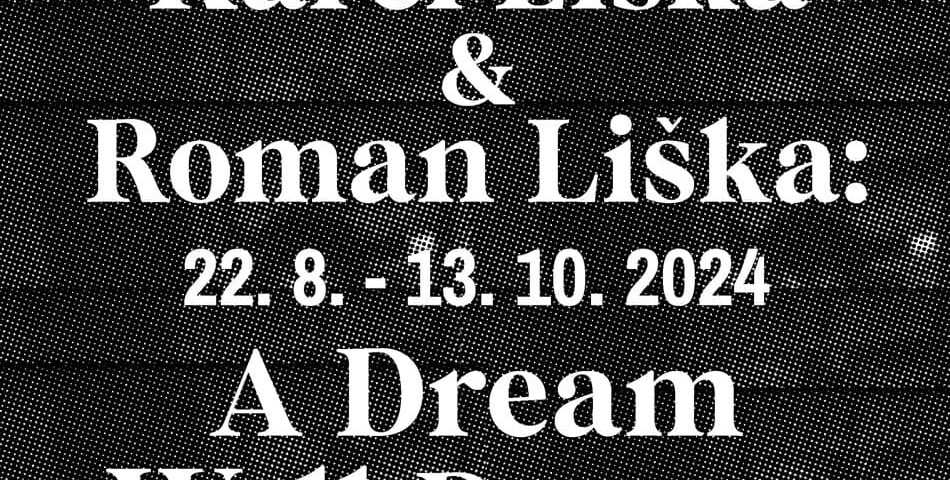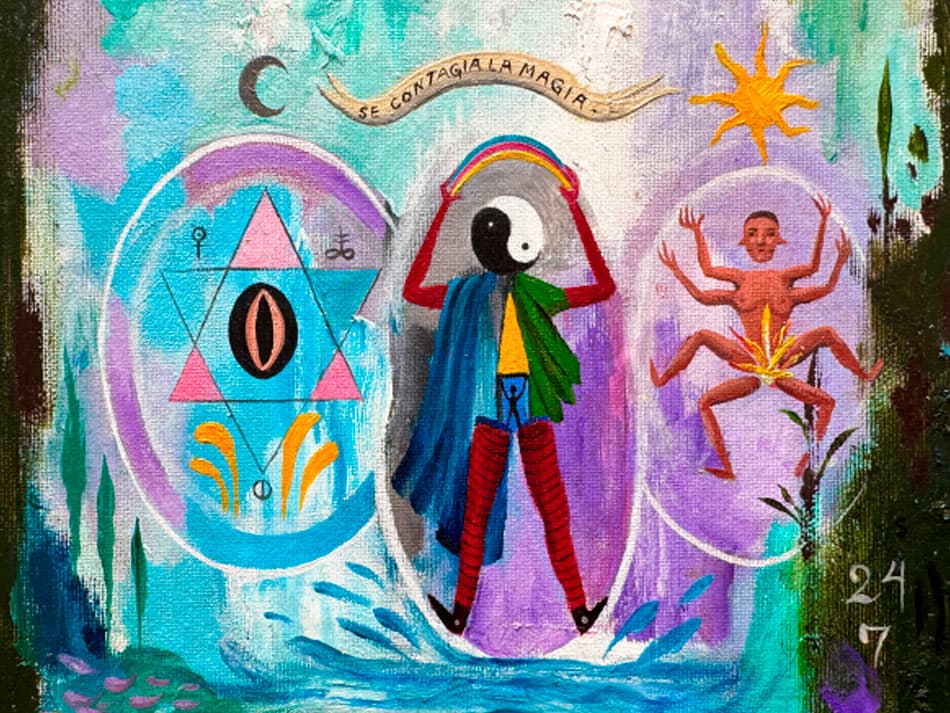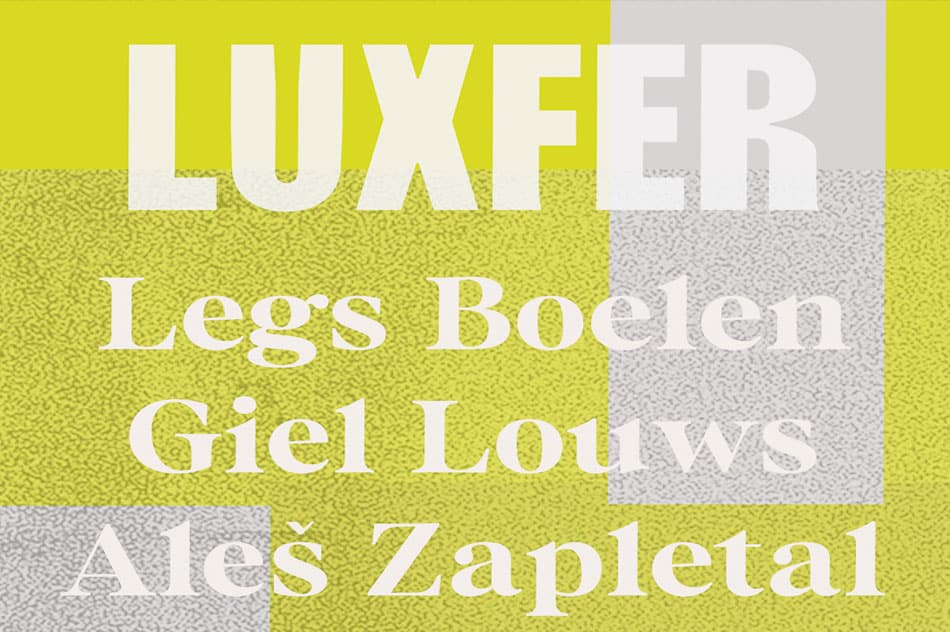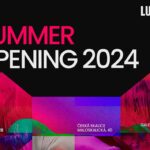
Luxfer Summer opening 2024
29. 7. 2024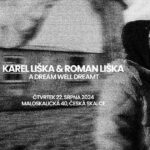
Rozhovor s Romanem Liškou
20. 8. 2024Dobře vysněný sen / A Dream Well Dreamt
22. 8. – 13. 10. 2024
Výstava *A Dream Well Dreamt* spojuje tvorbu umělců Romana Lišky (*1980 v Hamburku, Německo) a jeho zesnulého dědečka Karla Lišky (*1914 v Poltavě, Ukrajina – ✝ 1987 Daisendorf, Německo). Díla těchto dvou umělců z různých generací jsou v Luxfer Open Space uvedena do dialogu ve dvou odlišných prostorách. Jeden je prostor bílé krychle, zatímco druhý odhaluje původní architekturu historické minulosti budovy. Vystavená díla Karla Lišky vybral Roman Liška ze sbírky svého otce Ivana Lišky (*1950 v Praze, Československá republika). Tato díla pokrývají několik desetiletí, přičemž nejstarší data se datují do 1960 a nejnovější z roku 1987. Na této výstavě si povídají s díly jeho vnuka, odhalující jak odlišné přístupy, tak sdílené zájmy, jako je portrétování rodiny členů.
Název je odvozen z poněkud klišovité fráze „dobře žitý život“, což zase implikuje odvěká filozofická otázka, co může představovat dobrý život. „Dobrý sen“, pak koreluje s možná absurdním pojetím subjektivního jednání v rámci vlastních snů, nad kterými lidé většinou postrádají kontrolu, což naznačuje možnost ovlivňování svých snů, uvedení svých snů do existence – jinými slovy, možnost žít své sny.
Malba Karla Lišky má kořeny v akademické malbě. Rozhodl se zaměřit svou práci na krajinomalbu i (auto)portrét. Až do jeho nelegální emigrace z Československé socialistické republiky (ČSSR) s manželkou a třemi dospívajícími dětmi na Západ Německo v roce 1968 soustředil své cesty do zemí východního bloku, jako je Bulharsko, Maďarsko a Slovensko, kde připravoval skici k dílům, která později vytvořil ve svém ateliéru v Praze, kde také vyučoval na Hellichovce, pražské grafické škole. Jeho později díla byla vyrobena v jeho novém domově v Daisendorfu v západním Německu, poblíž Bodamského jezera, nebo při cestování po západní Evropě, včetně Francie, Itálie, Švédska, Nizozemska a Švýcarska.
Vystavená díla Romana Lišky sledují konceptuální přístup sanace: paravány jsou fragmenty pocházející z kresby, kterou vytvořil začátkem tohoto roku. Část originálu kresby byla následně vytištěna na banner 4 x 11 m, který byl vystaven na exteriéru zdi budovy od března do června 2024, ve které se nachází Luxfer Open Space, jako součást jejich série Galerie (Z)venku. Tento projekt pověřuje umělce, aby vytvořili umělecká díla pro vnější stěnu budovy galerie.
Na výstavě je nyní také původní kresba, ze které byl banner vytištěn, slouží jako klíč k odemknutí aktuální výstavy. Na kresbě je vyobrazen Tibor Karel David Liška (*2023 Berlín, Německo), novorozený syn Romana Lišky navazující na tradici svého dědečka rodinných portrétů. Umělec následně znovu použil tištěnou verzi banneru k vytvoření diskrétní abstraktní díla rozřezáním na různě velké kusy látky, které se pak napnutí působí jako abstraktní malby. Proces sanace od kresby přes tisk až po malbu je process, kterým se Roman Liška již v minulosti zabýval a nadále je středem zájmu umělcova dílo.
Překlad původních tahů této kresby, které pocházejí z umělcova zápěstí a prstů při tvorbě výkresu, jsou nyní transponovány a zvětšeny na velké plátno, vytvářející iluzi velkých gest připomínajících abstraktní expresionistický vizuální repertoár. Některá z těchto děl navíc fungují jako plátna k inscenaci Karlových obrazů Liška, čímž se status těchto objektů jako autonomních uměleckých děl ještě více komplikuje, vizuální a biografická síť odkazů procházející celou touto výstavou.
Ve vymýšlení nových způsobů prezentace a kontextualizace děl svého zesnulého dědečka, umělec Roman Liška možná navrhuje nový způsob chápání života uměleckého díla, jeho podstaty spolupráce a jak může být umění přepracováno tak, aby bylo nově viděno čerstvýma očima budoucí generace. Stejně jako u původní kresby je i tato výstava určena k překlenutí tohoto oblouku, sahá současně do minulosti i do budoucnosti, na jejímž vrcholu je naše přítomnost, s cílem vytvořit dobře vysněný sen.
Dears,
we would like to invite you to the opening of the exhibition A Dream Well Dreamt by the artists Karel Liška & Roman Liška, which will open at Luxfer Open Space (LOS) on Thursday, August 22, from 7 p.m.
Liška & Roman Liška: A Dream Well Dreamt The exhibition *A Dream Well Dreamt* brings together the work of artists Roman Liška (*1980 in Hamburg, Germany) and his late grandfather Karel Liška (*1914 in Poltava, Ukraine – ✝ 1987 Daisendorf, Germany). The works of these two artists from different generations are brought into dialogue at Galerie Luxfer in two distinct spaces. One is a white cube space, while the other reveals the original architecture of the building’s historical past. The works on display by Karel Liška were chosen by Roman Liška from the collection of his father, Ivan Liška (*1950 in Prague, Czechoslovak Republic). These works span several decades, with the earliest dating to 1960 and the most recent from 1987. In this exhibition, they converse with his grandson’s works, revealing both distinct approaches and shared concerns, such as the portraiture of family members.
The title is derived from the somewhat clichéd phrase „a life well lived“, which in turn implies the age-old philosophical question of what might constitute a good life. “A Dream Well Dreamt”, then, correlates with the perhaps absurd notion of subjective agency within one’s dreams, which humans usually lack control over, thus suggesting the possibility of influencing one’s dreams or bringing one’s dreams into existence—in other words, the possibility of living one’s dreams.
Karel Liška’s paintings are rooted in academic painting. He chose to focus his work on landscape painting as well as (self-)portraiture. Until his illegal emigration from the Czechoslovak Socialist Republic (ČSSR) with his wife and three adolescent children to West Germany in 1968, he concentrated his travels in Eastern Bloc countries such as Bulgaria, Hungary, and Slovakia, where he prepared sketches for works he would later create in his studio in Prague, where he also taught at Hellichovka, the Prague Graphic School. His later works were produced in his new home in Daisendorf, West Germany, close to Lake Constance, or while traveling in Western Europe, including France, Italy, Sweden, the Netherlands, and Switzerland.
The works on display by Roman Liška follow a conceptual approach of remediation: the screens are fragments originating from a drawing he produced earlier this year. A segment of the original drawing was subsequently printed onto a 4 x 11 m banner that was displayed on the exterior wall of the building from March to June 2024, which houses Luxfer Open Space, as part of their Galerie (Z)venku series. This project commissions artists to create artwork for the exterior wall of Galerie Luxfer’s building.
The original drawing from which the banner was printed is now also included in the exhibition, acting as a key to unlock the current exhibition. The drawing depicts Tibor Karel David Liška (*2023 Berlin, Germany), the newborn son of Roman Liška, continuing his grandfather’s tradition of family portraits. The artist subsequently reused the printed version of the banner to create discreet abstract works by cutting it into variously sized pieces of fabric that are then stretched to act as abstract paintings. The process of remediation from drawing to print to painting is a process Roman Liška has already employed in the past and continues to be a central interest in the artist’s oeuvre. The translation of this drawing’s original strokes, which come from the artist’s wrist and finger movements during the production of the drawing, are now transposed and enlarged onto a large fabric, creating the illusion of grand gestures reminiscent of the abstract expressionist visual repertoire. Furthermore, some of these works act as screens to stage the paintings of Karel Liška, thus further complicating the status of these objects as autonomous artworks within the visual and biographical network of references traversed throughout this exhibition.
In imagining new ways of presenting and contextualizing the works of his late grandfather, artist Roman Liška perhaps suggests a new way of understanding the life of an artwork, the nature of collaboration, and how art might be reimagined to be seen anew by the fresh eyes of future generations. Just as with the original drawing, this exhibition is intended to span an arc that reaches simultaneously into the past and into the future, at the apex of which is our present, in order to create a dream well dreamt.

